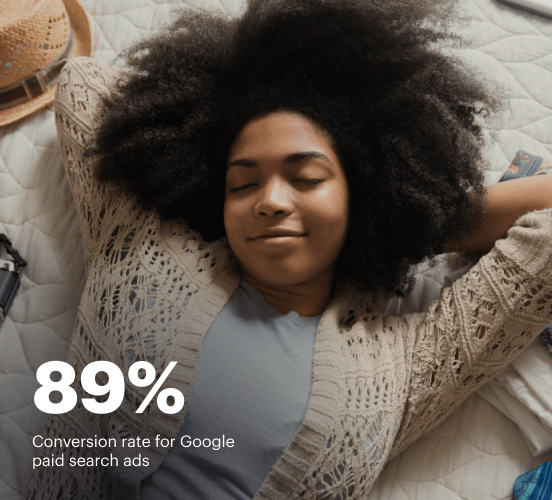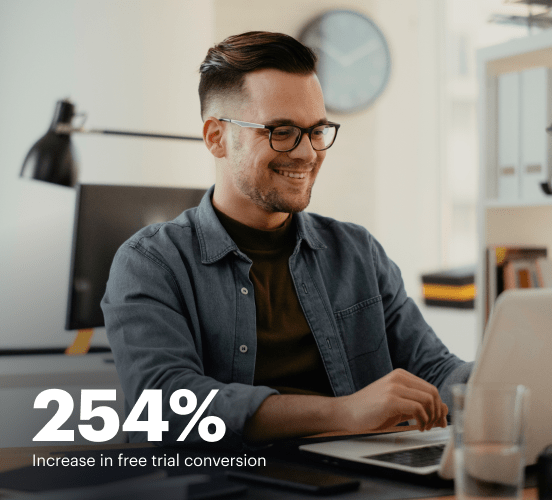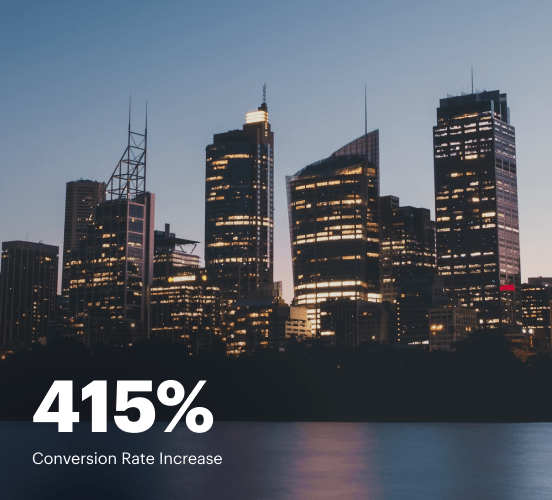How Webflow vs. Form.io vs. Instapage stack up against each other
Compare Instapage with Webflow and Form.io to create high-converting landing pages. With personalization, optimization, and collaboration tools, Instapage helps you deliver experiences that drive results.
Get startedSee how Instapage stacks up against the competition
| Feature | Instapage | Other builders |
| Drag-and-Drop Tools | ||
| Conversion-optimized templates | ||
| Manual and AI-powered A/B Tests | ||
| AI content suggestions | ||
| Popups and sticky bars | ||
| Canvas and grid blocks | ||
| Reusable and global elements | ||
| Form and popup builders | ||
| Built-in Heatmaps | ||
| Central analytics dashboard | ||
| Ad-to-page personalization and collections | ||
| Contacts, lists, and email | ||
| Dedicated, full-service CRO experts | ||
| Enterprise-ready platform |
Leading the way in building high-performing landing pages





Why Instapage is the smarter choice for your campaigns
Get everything you need to build, scale, and optimize high-converting landing pages—without coding.

Easier page building without coding
Instapage offers a flexible and seamless page creation experience with a library of 500+ conversion-focused layouts, Instablocks®, a drag-and-drop builder, and AI content generation. With technologies like Thor Render Engine®, you can create on-brand, mobile-responsive landing pages that load quickly and start converting during initial visitor clicks.

More insights — better results
Instapage lets you see in detail how each landing page experience and variation is performing so you can make targeted changes that boost page conversions. Use heatmaps for a better understanding of on-page activities, run A/B tests and AI-assisted experiments, and then track and evaluate results within robust analytics dashboards.

More personalized experiences
Instapage lets you quickly create high-performing landing pages tailored to each of your ad campaigns. Deliver personalized experiences for distinct audiences using dynamic text replacement. Effortlessly align specific advertisements to unique pages with AdMaps. Monitor audience-level metrics using our advanced data tools.

Built-in collaboration
Instapage collaboration capabilities bring your entire team together to speed up the process of landing page review, approval, and launch. No more frustrating and unnecessary revisions or edits scattered across emails. Provide instant feedback, conduct real-time page edits, and securely share your pages with outside stakeholders.

Free up time for your business
Invest time into business growth, not busy work. Launch landing pages faster with reusable forms and templates. Build once, reuse forever.
Explore all integrations






Easier page building without coding
Instapage offers a flexible and seamless page creation experience with a library of 500+ conversion-focused layouts, Instablocks®, a drag-and-drop builder, and AI content generation. With technologies like Thor Render Engine®, you can create on-brand, mobile-responsive landing pages that load quickly and start converting during initial visitor clicks.
More insights — better results
Instapage lets you see in detail how each landing page experience and variation is performing so you can make targeted changes that boost page conversions. Use heatmaps for a better understanding of on-page activities, run A/B tests and AI-assisted experiments, and then track and evaluate results within robust analytics dashboards.
More personalized experiences
Instapage lets you quickly create high-performing landing pages tailored to each of your ad campaigns. Deliver personalized experiences for distinct audiences using dynamic text replacement. Effortlessly align specific advertisements to unique pages with AdMaps. Monitor audience-level metrics using our advanced data tools.
Built-in collaboration
Instapage collaboration capabilities bring your entire team together to speed up the process of landing page review, approval, and launch. No more frustrating and unnecessary revisions or edits scattered across emails. Provide instant feedback, conduct real-time page edits, and securely share your pages with outside stakeholders.
Free up time for your business
Invest time into business growth, not busy work. Launch landing pages faster with reusable forms and templates. Build once, reuse forever.
Explore all integrationsGet started with Instapage in a few steps
-
Create your Instapage account
Start with Instapage by signing up via Google or your email. You'll get access to a free 14-day trial to discover Instapage capabilities. Feel free to cancel anytime during the 14-day trial if you decide that our product is not suitable for your business. -
Build and personalize your page
Create your first landing page from scratch or choose a template from 500+ customizable layouts. Use the drag-and-drop builder to add page elements, fonts, and backgrounds, refine content with AI, or add custom HTML, Javascript, and CSS. -
Review and make edits
Collaborate on page designs and streamline review processes. Invite your team members and stakeholders to review, edit, and provide feedback on your landing page. Collaborate knowing your page is confidential and only accessible to authorized users. -
Publish and track page performance
Publish your page to a domain or custom URL. Connect your pages to the ads you've created and track page performance within the analytics dashboard, run A/B tests and AI experiments, analyze results, and continuously optimize your landing page to maintain high conversions.
Instapage vs. Webflow vs. Form.io – Finding the Right Landing Page Builder
Choosing the right landing page builder can be likened to assembling your dream team for marketing success. Each contender brings unique abilities to the fore, with the potential to influence your conversion rates and customer engagement. Just like a superhero team, a good landing page builder should not only suit your project needs but also resonate with your marketing strategies. In this comprehensive comparison, we will pit Instapage against Webflow and Form.io to help you make an informed choice. Whether you’re a marketer, designer, or entrepreneur, understanding the nuances of these platforms can empower you to create effective landing pages that enhance customer loyalty, deliver measurable conversions, and bolster brand trust. Instapage, for instance, stands out as a powerful ally to marketers, enabling them to reduce costs while delivering relevant experiences that drive conversion rates higher than ever before. Through this article, we will dissect each platform’s strengths and drawbacks in terms of features, speed, usability, support, and pricing, making it easier for you to select the best fit for your goals.
Meet the Rivals: Instapage, Webflow, and Form.io
In our ring, we have three noteworthy platforms: Instapage, Webflow, and Form.io. Each one claims to be the best in its own right, but what truly sets them apart? Instapage has made waves in the marketing world with its robust tools that promote efficiency and optimize landing page performance. Known for its high-converting templates and user-friendly interface, it has become a go-to solution for marketers seeking to maximize their campaign successes. Webflow, on the other hand, caters to designers and developers who crave flexibility and control in their web projects. With powerful design capabilities, it allows for bespoke creations that go beyond simple landing pages, expanding users’ options for creative expression. Meanwhile, Form.io enters the scene as the ‘no-code’ solution, designed for teams looking to streamline form and data collection. Its unique offerings make it an excellent choice for businesses focused on data-driven decision-making and capturing leads. As we dive deeper into our comparison, we’ll examine their features, performance, and usability to understand which platform stands out the most in different scenarios.
First Bout - Exploring Features and User Friendliness
Template Selection and Ease of Use: A Showdown
When it comes to creating visually appealing landing pages, the variety of templates and ease of use can make or break the user experience. Instapage shines with an extensive library of high-converting templates crafted specifically for marketing purposes. Each template is easily customizable, allowing users to adapt designs rapidly without needing significant coding knowledge. Furthermore, Instapage's drag-and-drop editor simplifies the creation process, catering to both novices and seasoned marketers. Webflow, while offering a powerful set of design tools, has a steeper learning curve. Its flexibility can be overwhelming for beginners unfamiliar with web development principles. Design-savvy users will appreciate the immense control Webflow offers, but those seeking quick results might find it slightly challenging. Form.io, focused primarily on handling forms and data collection, may lack the diverse array of landing page templates compared to its competitors. However, its integration capabilities with API and other platforms make it an attractive choice for businesses particularly focused on data capture and management. After reviewing the features and usability of each platform, it's evident that different users will benefit based on their experience levels and objectives.
Instapage: A Leader in Customization and Conversion
Instapage positions itself not just as a landing page builder but as a comprehensive conversion optimization tool. The platform provides advanced analytics that allow marketers to track performance and see which elements are driving conversions. This data-driven approach enables users to make informed adjustments that enhance the efficacy of their landing pages. The extensive customization options, combined with A/B testing capabilities, ensure marketers can experiment with various approaches to discover which resonates best with their audience. Instapage empowers users to create tailored landing page experiences that not only boost conversions but also foster brand trust and customer loyalty. With features like personalized experiences based on visitor behavior, users can ensure that every landing page effectively communicates with visitors, increasing the chances of driving them toward desired actions.
Second Round - Assessing Speed and Performance
To kick off this round, let's talk about website speed – an essential aspect of user experience comparable to the frustration of waiting in line at your favorite café when you’re on a tight schedule. A quick loading time is crucial for retaining visitors and converting them into customers. When evaluating speed and performance, Instapage claims a competitive edge, boasting optimized loading times tailored for its landing pages. Webflow users often report good speed, but due to its design complexities, it may introduce longer load times depending on page elements. Form.io focuses on straightforward data operations and performs reliably, maintaining quick load speeds that facilitate smooth data collection processes.
Instapage Strengths in Speed and Performance
- Optimized for fast loading times, enhancing user retention
- Highly responsive designs across various devices
- Consistent performance even with high traffic volumes
- Integrated hosting capabilities that ensure quick page launches
Webflow Strengths in Speed and Performance
- Robust performance that can handle complex designs
- Customization may affect load times, but overall efficiency remains
- Responsive design elements minimize loading delays across screens
Form.io Strengths in Speed and Performance
- Quick response times due to lightweight form structure
- Suitable for projects centered around data collection without heavy media elements
- Delivers efficient data handling without compromising performance
In conclusion, speed and performance are pivotal in determining the efficacy of landing page builders. Instapage emerges as a clear favorite, offering optimized solutions that ensure swift loading and retention. However, depending on your project needs, Webflow and Form.io also present viable options, particularly for users looking for greater design flexibility or complex data handling.
Third Round - Navigating Usability and Learning Trends
Let’s take a friendly look at how each platform engages beginners and eases experienced users into their journeys. Instapage prides itself on its user-friendly interface, allowing newcomers to familiarize themselves without feeling overwhelmed. The intuitive design minimizes barriers, paving the way toward effective landing page creation from day one. In contrast, Webflow provides an innovative approach that caters to design enthusiasts. While it is powerful and versatile, it might challenge users without a design background. However, for those willing to put in the time, it can perform wonders. Form.io offers the benefit of being a no-code platform, appealing to users who prioritize simplicity and efficiency. Its streamlined onboarding process makes it approachable for all skill levels, so both seasoned developers and marketing professionals can create data-driven forms with confidence. Each platform supports users along their path, providing a conducive learning environment making it easier for anyone to master these tools.
Fourth Round - Customer Support Teams: Your Trusty Allies
Consider the customer support teams as our loyal sidekicks, always ready to provide the assistance you need when challenges arise. Instapage offers a robust support system, featuring live chat, email support, and extensive documentation, ensuring users can always access help whenever they need it. Moreover, its community forums provide a collaborative space where fellow marketers can share insights and strategies. Webflow boasts a comprehensive help center with articles and tutorials, and it offers live chat for premium users. However, users might find community engagement less active than Instapage. On the other hand, Form.io provides dedicated support primarily focused on enterprise customers. While its resources are reliable, users might find that general queries take longer to resolve compared to the more comprehensive support seen with Instapage and Webflow.
Fifth Round - Pricing Structures and Value for Money
Assessing the pricing structures of these platforms is essential for understanding which provides the best value for diverse business needs. Instapage offers various tiered plans that cater to different user requirements, with a focus on delivering advanced features tailored to marketing professionals. While the investment might seem considerable, users often find the ROI beneficial, given the platform's ability to drive conversions. Webflow employs a freemium model, allowing users to start for free before moving to premium plans, which can become pricey as users seek more advanced functionalities. Form.io offers custom pricing based on specific needs, emphasizing that it is oriented toward businesses prioritizing data and form-centric solutions. As readers reflect on the pricing and value of each platform, it's vital to remember that the perfect choice hinges on individual requirements, preferences, and long-term objectives.
Wrapping up this comparison, it's clear that each landing page builder brings something unique to the table. Instapage excels in providing marketers with optimized tools to create high-converting landing pages while enhancing brand trust and customer loyalty. Depending on your needs – whether you prioritize features, support, or pricing flexibility – each platform offers its own advantages. We encourage you to assess your requirements and take Instapage for a trial run to see how it can significantly contribute to your marketing success.










